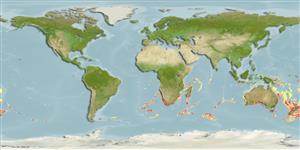Teleostei (teleosts) >
Zeiformes (Dories) >
Oreosomatidae (Oreos) > Oreosomatinae
Etymology: Oreosoma: Greek, oreos = mountain + Greek, soma = body (Ref. 45335).
More on author: Cuvier.
Environment: milieu / climate zone / depth range / distribution range
Ecology
Marine; bathydemersal; depth range 220 - 1550 m (Ref. 6548). Deep-water
Southeast Atlantic and Western Indian Ocean: around South Africa between 30° and 35°S. Southwest Pacific: Australia (including western and southern Australia) and New Zealand (Ref. 5755).
Size / Weight / Age
Maturity: Lm ? range ? - ? cm
Max length : 21.0 cm TL male/unsexed; (Ref. 6548)
Found on the continental slope. Benthic species (Ref. 75154).
Life cycle and mating behavior
Maturities | Reproduction | Spawnings | Egg(s) | Fecundities | Larvae
Karrer, C., 1986. Oreosomatidae. p. 438-440. In M.M. Smith and P.C. Heemstra (eds.) Smiths' sea fishes. Springer-Verlag, Berlin. (Ref. 6548)
IUCN Red List Status (Ref. 130435)
Threat to humans
Harmless
Human uses
Tools
Special reports
Download XML
Internet sources
Estimates based on models
Preferred temperature (Ref.
123201): 2.2 - 10.9, mean 7.5 °C (based on 594 cells).
Phylogenetic diversity index (Ref.
82804): PD
50 = 1.0010 [Uniqueness, from 0.5 = low to 2.0 = high].
Bayesian length-weight: a=0.01622 (0.00733 - 0.03589), b=3.03 (2.83 - 3.23), in cm total length, based on LWR estimates for this (Sub)family-body shape (Ref.
93245).
Trophic level (Ref.
69278): 3.4 ±0.5 se; based on size and trophs of closest relatives
Resilience (Ref.
120179): Very Low, minimum population doubling time more than 14 years (Preliminary K or Fecundity.).
Fishing Vulnerability (Ref.
59153): Low vulnerability (11 of 100).
